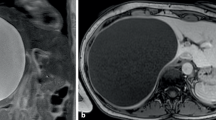Abstract
Background
Some reports have suggested that laparoscopic splenectomy (LS) can be successfully performed in adults. However, several aspects of this procedure remain as yet undefined; therefore, several attempts have been made to modify the standard technique to try to optimize the procedure. Herein we analyze our experience with 105 laparoscopic splenectomies.
Methods
From 1993 to 2000, 105 patients underwent LS at our hospital. Twelve of these patients also underwent a concomitant cholecystectomy. There were 66 women and 39 men whose ages ranged between 4 and 78 years (median, 27.7). All patients underwent an elective laparoscopic splenectomy. Seventy five patients had thrombocytopenia (ITP), 14 had hereditary spherocytosis, eight were affected by β-thalassemia, two had splenic cysts, two had lymphoma, (two had myeloid chronic leukemia, one patient presented with a splenic abscess and one had incurred an iatrogenic spleen lesion during adrenalectomy. The first patients in this series were positioned in dorsal decubitus; however, as the team’s experience increased, the right lateral decubitus became the position of choice because it provides better exposure of the splenic hilum. This procedure requires the use of only four trocars.
Results
Mean operating time was 95 min (range, 35-320). Hospital stay ranged from 2 to 21 days (median, 4.5). There was only one conversion to open surgery. One patient died in the postoperative period due to the evolution of a preexisting malignant disease. We recorded nine complication-four subphrenic abscesses, two cases of pleuritis, two episodes of postoperative bleeding, and one intestinal infarction 16 days after surgery. Only two patients needed redo surgery.
Conclusions
We believe that the laparoscopic approach is a valid alternative to open splenectomy, but mastery of some of the technical details of this procedure could greatly help avoid its complications. On the basis of our experience, it seems that the lateral approach should be considered the position of choice because it provides exposure and easier dissection of the splenic hilar structures. We also found that a 30° scope and an ultrasonic dissector allowed for perfect vision and optimal hemostasis during the procedure. At the end of procedure, the spleen should be fragmented and then extracted using an extraction bag.
Similar content being viewed by others
References
Backus CL, Park AE, Matthews BD, Heniford BT (2000) Minilaparoscopic splenectomy. J Laparoendosc Adv Surg Techn A 10: 259–262
Brody FJ, Chekan EG, Pappas TN, Eubanks WS (1999) Conversion factors for laparoscopic splenectomy for immune thrombocytopenic purpura. Surg Endosc 13: 789–791
Curran TJ, Foley MI, Swanstrom LL, Campbell TJ (1998) Laparoscopy improves outcomes for pediatric splenectomy. J. Pediatr Surg 33: 1498–1500
Esposito C, Corcione F, Ascione G, Garipoli V, Di Pietto F, De Pasuale M (1998) Splenectomy in childhood: the laparoscopic approach. Surg Endosc 12: 1445–1448
Gigot JF, Jamar F, Ferrant A, van Beers BE, Lengele B, Pauwels S Pringot J, Kestens PJ, Gianello P, Detry R (1998) Inadequate detection of accessory spleens and splenosis with laparoscopic splenectomy: a shortcoming of the laparoscopic approach in hematologic disease. Surg Endosc 12: 101–106
Gigot JF, Lengele B, Gianello P, Etienne J, Claeys N (1998) Present status of laparoscopic splenectomy for hematologic diseases: certitudes and unresolved issues. Semin Laparosc Surg 5: 147–153
Gossot D (1998) Laparoscopic splenectomy: value of the posterior approach. Ann Chir 52: 940–945
Gossot D, Fritsch S, Celerier M (1999) Laparoscopic splenectomy: optimal vascular control using the lateral approach and ultrasonic dissection. Surg Endosc 13: 21–25
Katkhouda N, Waldrep DJ, Feinstein D, Soliman H, Stain SC, Ortega AE, Mouiel J (1996) Unresolved issues in laparoscopic splenectomy. Am J Surg 172: 585–589
Morris KT, Horvath KD, Jobe BA, Swanstrom LL (1999) Laparoscopic management of accessory spleens in immune thrombocytopenic purpura. Surg Endosc 13: 520–522
Park AE, Birgisson G, Mastrangelo MJ, Marcaccio MJ, Witzke DB (2000) Laparoscopic splenectomy: outcomes and lessons learned from over 200 cases. Surgery 128: 660–667
Park A, Gagner M, Pomp A (1997) The lateral approach to laparoscopic splenectomy. Am J Surg 173: 126–130
Poulin EC, Mamazza J (1998) Laparoscopic splenectomy: lessons from the learning curve. Can J Surg 41: 28–36
Rescorla FJ (1998) Laparoscopic splenectomy. Semin Pediatr Surg 7: 207–212
Rogers J, Yousuf A, Kleinhaus S (1997) Laparoscopic accessory splenectomy in recurrent chronic immune thrombocytopenic purpura. Surg Laparosc Endosc 7: 83–85
Szold A, Sagi B, Merhav H, Klausner JM (1998) Optimizing laparoscopic splenectomy: technical details and experience in 59 patients. Surg Endosc 12: 1078–1081
Targarona EM, Espert JJ, Balague C, Piulachs J, Artigas V, Trias M (1998) Splenomegaly should not be considered a contraindication for laparoscopic splenectomy. Ann Surg 228: 35–39
Targarona EM, Espert JJ, Balague C, Sugranes G, Ayuso C, Lomena F, Bosch F, Trias M (1998) Residual splenic function after laparoscopic splenectomy: a clinical concern. Arch Surg 133: 56–60
Author information
Authors and Affiliations
Additional information
Online publication: 26 March 2002
Rights and permissions
About this article
Cite this article
Corcione, F., Esposito, C., Cuccurullo, D. et al. Technical standardization of laparoscopic splenectomy. Surg Endosc 16, 972–974 (2002). https://doi.org/10.1007/s00464-001-9007-8
Received:
Accepted:
Issue Date:
DOI: https://doi.org/10.1007/s00464-001-9007-8




